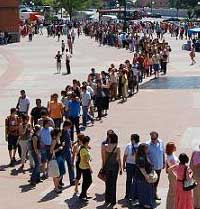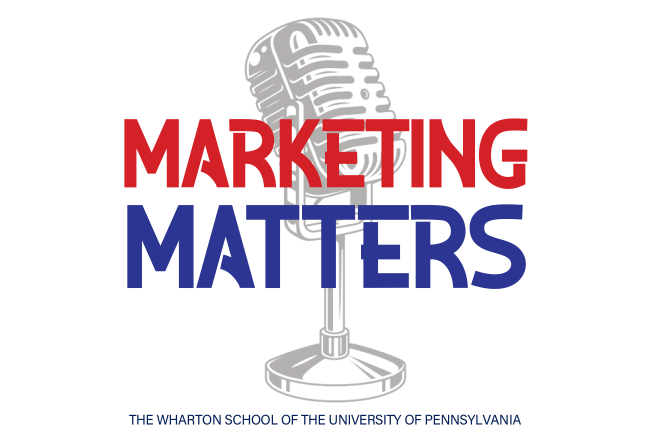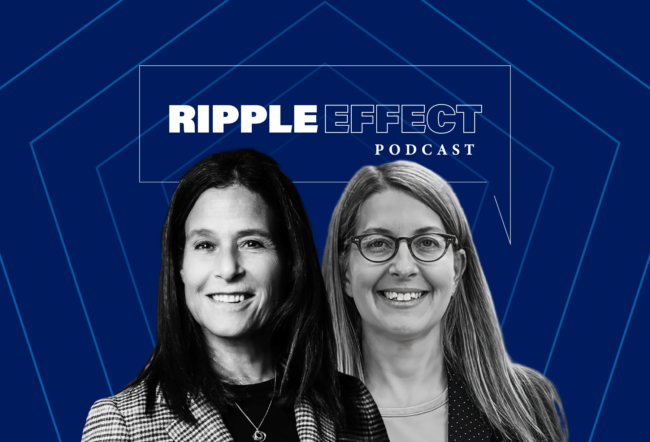In American universities, there’s a golden rule among students: If a teaching assistant is late to a lecture, wait ten minutes. If it’s an associate professor, wait 15 minutes; a professor, wait up to 20 minutes.
A very similar rule can be applied in the business world, according to Diana Gavilán Bouzas and Jesús García de Madariaga of the marketing and market research department at the Complutense University in Madrid. "If customers want something more than an alternative, it is worth the wait," write the two professors in a recent paper published in the Universia Business Review, titled, "Do We Wait Because It Is Better or Is It Better Because We Wait?: An exploratory study of the relationship between waiting time and perceived value."
The authors explain that other research in this field has tended to be carried out from the starting point that waiting is something that is not good. Yet they argue that there can be positive effects because of the relationship between waiting and the value of a good or service. As they note, waiting can increase the expectations about the value of a choice of product and the value – because of the way it was perceived in previous experiences or is anticipated – can lead customers to tolerate having to wait.
According to Gavilán, "Although the people who manage [products and] services run away from delays like the plague because, ‘They are very bad for business, because people get very angry’ – in reality, there is a clear belief [among consumers] that you only wait for things that are good." What this means from a business point of view is that understanding the positive impact of delays could be beneficial for a company. "If making a customer wait enhances the value of your products and services, or if on the contrary, the anticipated value justifies the wait, the operating margin of the organization widens considerably," notes the paper.
A Two-way Street
To study the relationship between delays and the effect on the value of a product, Gavilán says the researchers demonstrated what happens when people are forced to accept scenarios involving delays, describing how they reacted and which products they chose or rejected. In a study on amusement parks, for example, the researchers described each attraction to the study’s participants – since consumers who are waiting in a line for something usually don’t know what the end experience will be – and they told the participants what the waiting times for each attraction would be. Afterwards, participants were asked to rate which ride was more exciting and what they liked most about what they spent their money on. For most people, the study revealed, the attraction that had the longest waiting time was ranked as the most exciting. "Without a doubt, if something is good, you have to wait for it; and if you have to wait, it is good," she says. "It works in both senses. There is a curious bi-directionality, although it’s hard to know very well what is the cause and what is the effect."
The research paper also notes that when consumers assign a high value to a product or a service, they can wait longer than for products they deem to be of lower value, with less of a negative psychological effect. Put another way: The value makes the customer absorb the cost of the delay. Consider the recent global launch of the Apple iPhone in Spain, which led to long lines. The first customer spent 17 hours waiting outside the door of an iPhone retailer.
However, for each consumer, a weighing process takes place between two variables: the perceived value of a product or service to the person who waits for it (the benefit), and the waiting time (the cost). A consumer will accept a delay as long as he believes that his situation will improve for having waited. That means increasing the anticipated value of the good or service is the "best thing that a provider can do to manage the delay effectively," according to the professors.
That said, delays are intrinsically unsatisfying for the majority of consumers. If consumers collectively demand more than what is supplied and are still willing to wait, it could be because the alternatives to having that particular product or service are less desirable, and therefore make the waiting process seem less onerous.
Waiting to acquire a product or service can add value to it, making it more attractive, exclusive and satisfying. Nevertheless, this does not mean that the increase in the value caused by the delay necessarily must improve the perception of the good or service when it is received. What’s more, the consumer could interpret the delay as an added cost.
All That Glitters…
One major challenge, however, is that the rules of consumer behavior are not necessarily rational. Customers often don’t have sufficient information to judge a service, or the mechanism that they use for evaluating it can be mere statistical or extrinsic attributes. As such, write the authors, "when a large number of people agree to choose the same offering, leading to a delay [even though] there are alternative [products or services], the proof of the value of their choice becomes very easy to see."
Gavilán notes that this is known as the “heuristic rules” of decision-making. The consumer is not entirely rational but uses decision-making rules that are very intuitive, based on reasoning that tends to be unsubstantiated. "For example, a very easy heuristic rule is that things that are covered with gold are better," she explains. "Bonbons are wrapped in gold paper. They don’t wrap them in brown paper, although that is a very good material. If you want something to look better, you put it in something that is gold and shiny." This involves a simple decision-making rule: "Instead of analyzing thousands of factors, a consumer bases his decision on the one detail that is a good enough reason to take a decision," she says.
Given this irrationality, "the mechanism for making decisions is based on very selective information," she adds. "One of the most frequently used sources of information – and the least studied – is how long you need to wait."
Consider what happens when you go to a crowded restaurant, says Gavilán. You take in thousands of inputs: the design of the restaurant, the size, the menu, the prices, etc. But you are left with one detail: That there are several people lining up waiting for tables.
This scenario was presented to 112 study participants, between the ages of 25 and 65 years old. They were asked to choose between a restaurant with a line and one without. Other scenarios asked them to consider buying television sets with different delivery periods; lawyers and the length of time it would take to get an appointment with them; three leisure options and how long people were willing to wait for each; and evaluating doctors first based on a description of their practice and then whether there would be a delay to get treated.
Based on their research, the authors found that in order for a delay to generate value, at least one of five conditions has to be fulfilled:
1. There need to be alternatives. A customer must be aware that while alternatives are feasible, accessing them is not as desirable. "If you go to a government office and you are made to wait a long time, you don’t think that this is because you are going to receive very good service," says Gavilán. "The waiting is due to the fact you can’t choose among various alternatives." When customers have alternatives, they are getting information about different goods and services, and that’s when a company can exploit the heuristic rule.
2. A customer can’t think the delay has happened because the business is running in a defective way or he asked for the good or service at the wrong moment. "A customer will not believe that the delay has to do with value if he thinks that he is responsible for it, that he has made a mistake when making his selection. For example, if you go to a restaurant one Saturday and think, ‘There are so many people here because it is Saturday. I should have come another day,’" notes Gavilán. Rather, the wait generates value when a customer is convinced that the situation is the result of other customers agreeing that the selection is a good choice, reinforcing his selection.
3. Information obtained during the delay helps reduce risk. That explains why a line outside of a shop is like a magnet drawing new customers to it. In attempting to maximize the satisfaction and minimize the risk of his choice, a customer watches the conduct of other buyers. A shop full of customers or a restaurant with people waiting for a table will always be more attractive than an empty shop or restaurant.
4. The principle of scarcity is activated. The less easily available something is, the more attractive it becomes. That is, the fear of being unable to get the product automatically increases its appeal.
5. There’s a belief that the waiting is a result of the development time needed by the supplier to guarantee quality. A patchwork overcoat made by the high-end fashion house Dolce & Gabbana costs 3,585 euros and takes four weeks to deliver, the same time it can take to deliver a new car.
Eliminate, Camouflage, Mitigate?
When applying the study’s findings to their own companies, Gavilán recommends managers ask: Does the company need to eliminate the delay, or is it better to ‘camouflage’ or mitigate it? People react in various ways when they have to wait. From an emotional viewpoint, there is boredom, anxiety, uncertainty or anger. From a behavioral viewpoint, there are complaints, demands or abandonment of the service. So while making customers wait can be good for a company because of the perception of increased value, it can also cause collateral damage. But rather than eliminating the waiting, Gavilán recommends eliminating the negative aspects associated with it by providing an overall experience that is "so pleasant that the waiting doesn’t matter for the customer."
From the vantage point of marketing, the waiting process "has to be a source of [positive] experiences in services because that way you acquire everything that is positive about the waiting," she says. "It would be better to dispense services where there is a delay … even though that is an extra cost that the customer must pay for. But this … can help you look better and make the wait more tolerable," she explains.
Another point to consider is how much face-to-face or physical contact a customer has with a company while waiting. According to Gavilán, physically waiting in a line is "much more sensitive and requires a lot more distractions." If a customer has to invest time by waiting in that line, distortions begin if the business hasn’t thought enough about that experience. "If I make [a customer] wait for a long time because the customer thinks he’s getting something better, that’s okay," she explains. "But if the wait is too long, the customer thinks that you are rude or that the service is bad. The waiting process can help a company, but be careful because it has its limits."
Things change when the waiting is not done in a specific location. "The fact that people need to wait five months for you to deliver a product generally leads them to think that the product is better.… That sort of delay doesn’t require the customer to make any great effort." High-end auto companies have very long delivery periods, which enables people to use the waiting time to test out the model or get involved in some sort of activity instead of waiting, and that also makes it more desirable.
Instead of recommending that businesses focus all their efforts on eliminating delays as other studies do, the Complutense professors prescribe a different strategy for three reasons: People distinguish between different types of waiting experiences; waiting can be a business opportunity; and it can minimize problems.
How can a company improve how it manages the waiting process? The professors offer the following measures: Intensify efforts to shorten the perceived duration; improve physical conditions in the waiting location; provide distractions; and position the waiting at the appropriate moment in the service process – that is, "it is better to wait until after you have begun providing the service than before the customer senses that you have begun tending to him," they write.
In economic terms, the cost of these measures may be hard to justify at face value. And while the effort is greater than if a company took different measures to eliminate the waiting altogether, the researchers conclude that "the advantage is the perception of superiority: If we need to wait, it is a better product, and if it is a better product, we are willing to wait."



